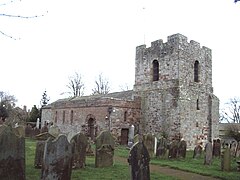Burgh-by-Sands
| Burgh by Sands | |
|---|---|
 St. Michael's Church, Burgh by Sands |
|
| Burgh by Sands shown within Cumbria | |
| Population | 1,176 (2011) |
| OS grid reference | NY326592 |
| Civil parish |
|
| District | |
| Shire county | |
| Region | |
| Country | England |
| Sovereign state | United Kingdom |
| Post town | CARLISLE |
| Postcode district | CA5 |
| Dialling code | 01228 |
| Police | Cumbria |
| Fire | Cumbria |
| Ambulance | North West |
| EU Parliament | North West England |
| UK Parliament | |
Burgh by Sands (pronounced as "Brough", /ˈbrʌf/ BRUFF) is a village and civil parish in the City of Carlisle district of Cumbria, England, situated near the Solway Firth. The parish includes the village of Burgh by Sands along with Longburgh, Dykesfield, Boustead Hill, Moorhouse and Thurstonfield.
According to the 2011 census the parish had a population of 1,176. The village is about seven miles (11 km) west of Carlisle city centre. The village has a primary school, a pub and a post office. It also has a statue of Edward I. Burgh was on the Carlisle Navigation canal from 1823 to 1853, after which it was served by the Port Carlisle railway, which was built on the bed of the canal, until its closure in 1932. From 1856 to 1964, railway trains operating on the Carlisle to Silloth line once again stopped at Burgh-by-sands station.
Burgh is "doubtless so named from the 'burh' or fort on Hadrian's Wall which ended here." ('Burh' is Old English for 'fortified place', 'town' or 'manor house').
Hadrian's Wall runs through the village, and the site once was that of a Roman fort, Aballava. It has also been expostulated by historians as a possible site for the semi-mythical Avalon where King Arthur died and the legendary Excalibur was forged.
...
Wikipedia

